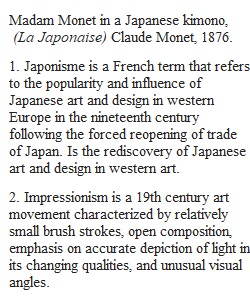


Q Watch video, Katsashika Hokusai, The Great Wave offshore at Kanagawa in modules. Return to answer question. More research will be necessary to fully answer the questions. Hokusai’s art was an important influence on American and European Art. Artworks by him and other Japanese artists inspired an art movement called Japonium which inspired art movements in western culture for 5 decades. In your discussion, you are to Post early and choose an artwork by one of the artists listed below. Then embed an image by the artist you chose that reflects Japonism. Give the artist name, title of the art, and date. Answer the following questions and use the question numbers to number your answers. Respond to another student’s post with new factual information. 300-word minimum. 1. Define Japonium or Japonisme (French) 2. Define the art movement associated with the artwork you chose. (See Chart) 3. Discuss how Japonium and/or Hokusai influenced the specific artwork you chose. 4. What specific imagery, colors, design elements, and compositional choices in the artwork can be attributed to Japonium. Give specific examples for credit. Artist Date of Birth Date of Death Nationality Style James McNeill Whistler (Links to an external site.) 1834 1903 American Realism (Links to an external site.), Impressionism (Links to an external site.) Édouard Manet (Links to an external site.) 1832 1883 French Realism (Links to an external site.), Impressionism (Links to an external site.) Claude Monet (Links to an external site.) 1840 1926 French Impressionism (Links to an external site.) Vincent van Gogh (Links to an external site.) 1853 1890 Dutch Post-Impressionism (Links to an external site.) Edgar Degas (Links to an external site.) 1834 1917 French Impressionism (Links to an external site.) Pierre-Auguste Renoir (Links to an external site.) 1841 1919 French Impressionism (Links to an external site.) Camille Pissarro (Links to an external site.) 1830 1903 Danish-French Impressionism (Links to an external site.), Post-Impressionism (Links to an external site.) Paul Gauguin (Links to an external site.) 1848 1903 French Post-Impressionism (Links to an external site.), Primitivism (Links to an external site.) Henri de Toulouse-Lautrec (Links to an external site.) 1864 1901 French Post-Impressionism (Links to an external site.), Art Nouveau (Links to an external site.) Mary Cassatt (Links to an external site.) 1844 1926 American Impressionism (Links to an external site.) Aubrey Beardsley (Links to an external site.) 1872 1898 English Art Nouveau (Links to an external site.), Aestheticism (Links to an external site.) Alphonse Mucha (Links to an external site.) 1860 1939 Czech Art Nouveau (Links to an external site.) Gustav Klimt (Links to an external site.) 1862 1918 Austrian Art Nouveau (Links to an external site.), Symbolism (Links to an external site.) Pierre Bonnard (Links to an external site.) 1867 1947 French Post-Impressionism (Links to an external site.) Frank Lloyd Wright (Links to an external site.) 1867 1959 American Prairie School
View Related Questions